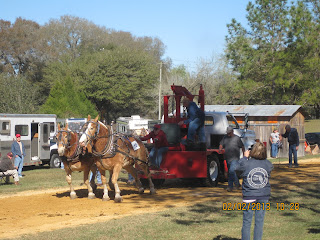It was a sunny but chilly morning 5.6C (41.5F)
By 8:45 when we set off to fond a Flea Market, it had warmed up to 8C (46.4F). On the way to find the Flea Market, we passed by Pioneer Florida where there were State Troopers cars with lights flashing.
We continued on to find the Flea Market, which turned out to be a lot of junk, but I did pick up some fresh vegetables.
On our way back to the park, we decided to check out the Pioneer Florida Museum since there was a steady stream of vehicles going in.
In 1961, a prominent citizen of San Antonio, Florida, offered a variety of old farm equipment to the Pasco County Fair Association. The Association accepted 37 vehicles and tools of yesteryear. This gift provided the incentive for forming the Pioneer Florida Museum Association with 87 Charter Members. The main Museum is housed in a 50' by 100' steel building, which features a wide rustic front porch, an addition of a medical room. Also on the grounds stands the restored Overstreet House, a one-room school house from Lacoochee, a church from Enterprise, the Trilby depot, and a train engine. Moving and restoration was completely paid for by private contributors. The 16 beautiful wooded acres were a gift from a Museum Association Charter Member. The Association has established a Museum that recalls the basic, simple values of our forebears, asserts the dignity of labor, and emphasizes the value of craftsmanship.
As it happened, at 10:00, just when we arrived, the Heavy Class Horse Pull was starting. They got up to 3500 pounds. Those poor horses! There are many teams from all over competing.
It is certainly a popular event as there were hundreds in attendance! Check out www.pioneerfloridamuseum.org
There were also several vendors selling various food items. We shared an Arepa for lunch The arepa is a flat, round, unleavened patty made of cornmeal which can be grilled, baked, boiled, or fried, steamed etc. The characteristics vary by color, flavor, size, and the food with which it may be stuffed, depending on the region. Arepa is a native sort of bread made of ground corn (or flour), water, and salt which is fried into a thick bread. It was filled with mozzarella cheese - can you say decadent?
We walked around the grounds & through the buildings, then came across the Sugar Cane Syrup making mill. They grow sugar cane here, as well as buying it from local farmers.
The Pioneer Florida Museum has a Cane Syrup Mill complete with hard working mule. Demonstratons of cane grinding and syrup making are presented during the year at special events.
Sugarcane was a Pioneer Florida cash crop and was harvested mostly by hand and sometimes mechanically. The museum has a mill grinder which could produce income for a pioneer family. Hand harvesting still accounts for more than half of the world's production. Harvesters use cane knives or machetes, cut the standing cane just above the ground.
The bowl-shaped cooker is an 80 gallon syrup kettle permanently installed in a brick furnace which was built by former County Agent Luthar Rozar. In keeping with old-time ways, the furnace is fired with "liter knots" which must be scavenged from local pastures and wooded areas. It takes eighty gallons of cane juice cooked down to produce six to eight gallons of syrup. This labor intensive process takes six to eight hours to complete.
As we were making our way to the exit, we came across the "Light Class" Horse Pull, which we stayed to watch. When that event was over, it was a mass evacuation from the park.




No comments:
Post a Comment